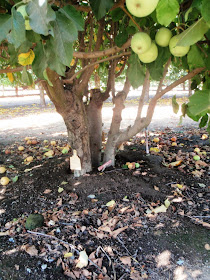Q. The day after I planted seedlings in my 4x8 raised bed I
noticed they were decimated by some kind of insect. When I was amending the
soil I noticed some small worm-like critters in the soil. I sprayed Bt but it
evidently didn't do anything to help the situation. I was told to use a powder
called "milky spore disease" to kill any grubs or grub-like insects
in the soil. Have you ever heard of this product? They said it works and I only
have to apply it one time. Can you advise me on this product and where I might
find it or some other solution?
 |
| Decimated pepper |
A. The milky spore product only works on Japanese beetle and
a few closely related insects which we do not have in southern Nevada. It is a
bacterium and works rather slowly, if it will work at all, on pests we have in
southern Nevada.
Bt works differently.
It works on those insects that mature or pupate into either moths or
butterflies. So if the immature insect turns into a beetle for instance it will
not work. So without knowing which insect is doing damage it is hard to know
what will work.
 |
| Cutworm larva |
The other
alternative is to use a conventional pesticide approved for use on vegetables
and has insect grubs or larvae on the label. These insecticides leave a
poisonous residue for longer-lasting insect control.
This time
of year Bt is a good product to use because it will control many of the insects
causing damage right now. Look for products with a label that says Dipel or
Thuricide. Forget the milky spore bacterium control in your case.
I am
sending you a picture of what the cutworm larva looks like and its adult form,
a moth. I will also post it on my blog. Bt can be sprayed on the soil and left
undisturbed (no hoeing or irrigating after the application) for a few days but
you have to repeat your applications to get any long term control.
 |
| Corn earworm moth adult http://ipm.illinois.edu/ifvn/volume15/frveg1506.html |
This is the
time of year that moths are flying, mating, laying eggs and larvae are out
looking for food. Usual cutworm damage is at the soil surface, not on the
leaves.

+compressed.jpg)

